We all love the thick and broad leaves of our Aloe Vera plants, but it is frustrating to see these leaves becoming mushy. Do you know why that happens? Let’s find out.
Excess moisture in the soil or around the plant leads to mushy leaves in the aloe vera plant. Overwatering, poor drainage, and high humidity are primary causes of excess moisture. To prevent this, use well-drained soil, water them sparingly, provide enough sunlight, and maintain low humidity.
This guide will explain all the reasons behind the Aloe Vera plant turning soft and mushy. We will also share how to treat the mushy Aloe Vera plant and some care tips to maintain a healthy Aloe Vera plant.

Why is my Aloe Vera plant getting mushy?
The Aloe Vera plant turns mushy due to high moisture levels.
And high moisture level occurs due to varied reasons.
There can be other reasons behind mushy leaves too. Let’s take a quick look at all of them.
- Overwatering
- Soil-retentive soil
- Wrong container
- High humidity levels
- Lack of sunlight
- Sunburn
- Cold injury
Let’s learn how these reasons increase the plant’s moisture content and make the leaves mushy.
Overwatering
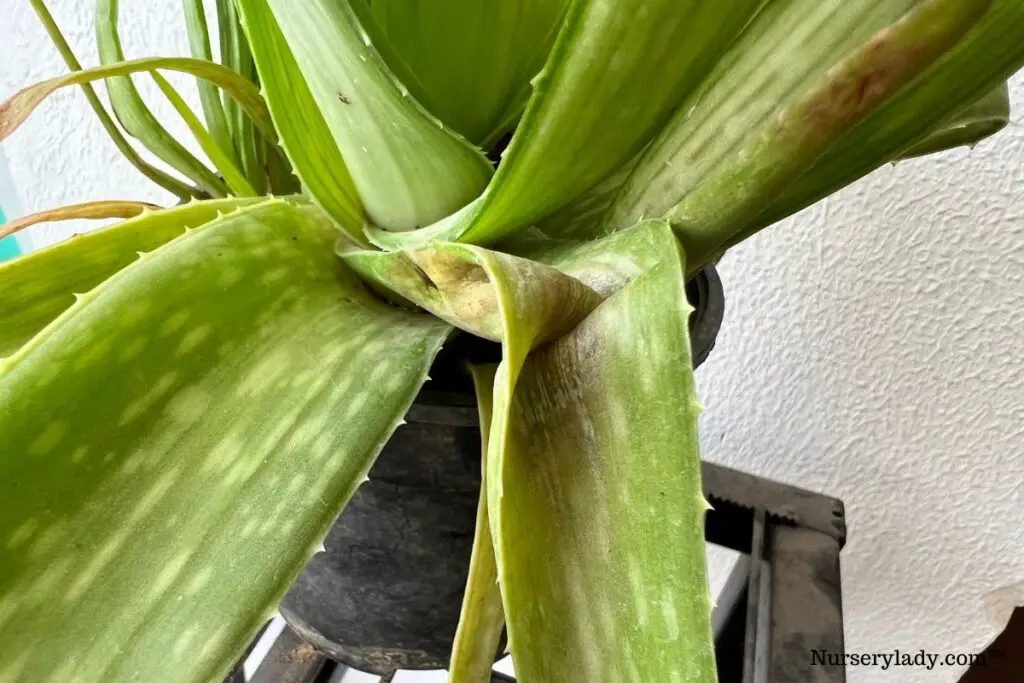
Overwatering is, by far, the most common reason behind mushy leaves in the Aloe Vera plant.
Aloe Veras are native to the arid, desert environment of the Arabian Peninsula in Oman.
In these regions, the Aloes grow in sandy soils that don’t hold water for long, and rainfall is infrequent.
Additionally, being succulents, the Aloe Vera plant can store water in its leaves as a technique to survive the high temperatures and dry weather.
Since Aloes are adapted to such growing circumstances, they are vulnerable to overwatering.
They can absorb water greatly.
So, if you water them too frequently (more than once a week), and they continue to consume too much of it, the leaves will become soft and mushy.
Along with mushy leaves, the other symptoms of overwatering are damp soil and discolored and transparent leaves.
If black leaves accompany mushy leaves, it is an obvious sign of rot.
Your plant may end up dying if the problem extends.
But, don’t worry.
Your mushy Aloe Veras can be saved if you reduce watering and follow a correct routine with the right frequency.
How to improve watering habits?
Generally, your Aloes are ready to take water when the soil around their root system has dried.
- Watering the Aloe Veras once every 2-3 weeks is the right way to give them the water they need. It will prevent them from turning mushy and keep them healthy.
- If you are a beginner and want to know the right watering frequency, you should first check the soil’s moisture level. It helps to know their watering needs better. When the top 2-3 inches of the soil is dry, the plant is ready to take more water.
- You can check the moisture level through the drainage holes if the plant is in a pot. Delay for some more days if it feels moist. If the soil is dry, it is the right time to water.
- Once you have gathered experience by checking the soil moisture, you will know the correct watering routine and maintain a proper balance according to the surrounding situations in your garden or home.
- The routine might differ throughout the year depending on the season. In winter, watering once a month would be enough. In the summers, they might need watering once a week. But, they would rarely need watering during summer dormancy ( when temperatures rise above 80-90°F).
- If the mushiness spreads from a few leaves to other healthy leaves, try propagating the healthy leaves and save your whole Aloe Vera from dying.
Also read: How To Water Aloe Vera Plant? (How often, Summer, Winter)
High moisture-retentive soil
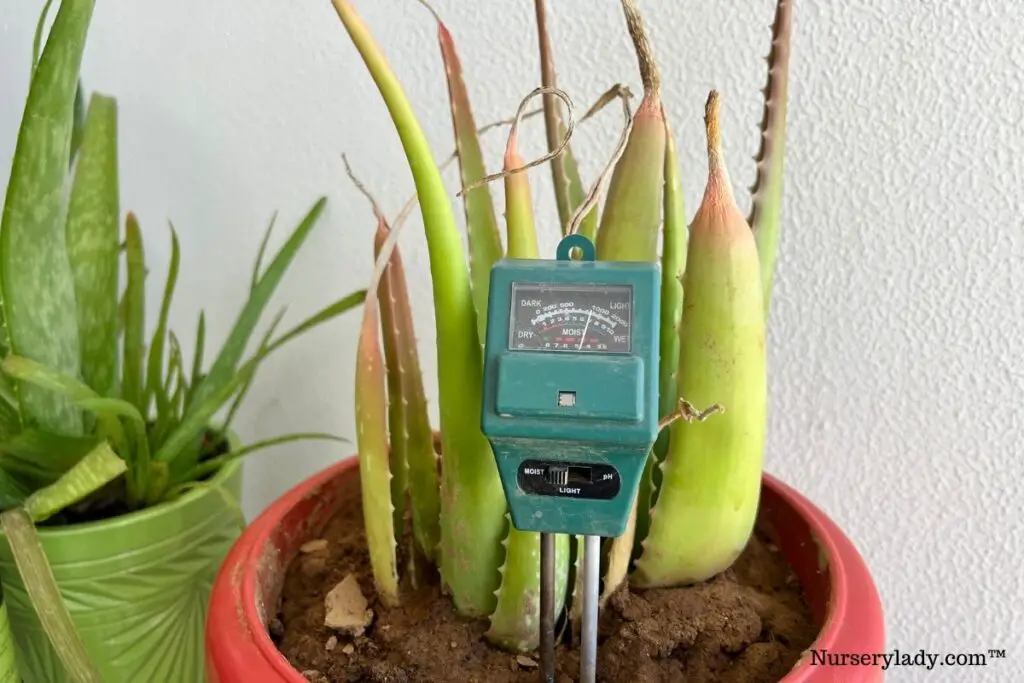
Even if you are watering correctly, the soil is still moist, and the leaves are mushy.
It could be due to slow draining or moisture-retentive soil.
Aloe Veras will not grow well if planted in any ordinary soil.
That will keep the soil damp for a long time.
The leaves will turn yellow or brown and become mushy if the soil retains too much moisture around the roots for a long period.
A poorly drained soil will have the same effects as overwatering because the soil won’t dry out faster.
Since your Aloes enjoy dry conditions, you should use a soil mix that contains porous materials to drain the water faster.
Check the condition of the soil through the drainage holes. If it’s wet rather than moist, you should change the soil.
What kind of soil is good for Aloe Vera?
Generally, belonging to dry areas, Aloe Veras grow best in sandy and gritty soil that doesn’t hold moisture for long periods.
For preventing mushy leaves in the Aloe Vera plant, you should try to imitate the same soil conditions for Aloe Vera as in their native land.
You can use a commercial cactus and succulent potting mix made specifically for all the succulents.
It is gritty and drains all the excess water from the soil and remains almost dry, just like their native land.
You can also make a soil mix yourself. Below are some recommendations:
- Clean garden soil, sand, and perlite with the ratio of 1:1:1 and a half part compost
- Equal parts of garden soil, coarse sand, and peat moss
- 3 parts of potting soil, 2 parts of pumice, and 1 part peat
- 50% of pumice and 50% of potting soil
Once the Aloe receives the ideal soil mix, enough time to dry out, and adequate watering, the leaves will revive and become thick and plump again.
Add some small pebbles or stones to the bottom of the containers.
These stones won’t let any soil or debris block the drainage hole and allow the water to flow out easily.
Also read: What Type Of Soil For Aloe Vera Plant? (+Ideal Soil Mix)
Looking for gardening supplies? We have tested 100's of products before recommending them to you guys. Check out our best pick below:
| Image | Gardening Supplies | Best Price? |
|---|---|---|
 Top
Top Top
Top | Raised Garden Bed Kit | Check On Amazon |
 | XLUX Soil Moisture Meter, Plant Water Monitor, Soil Hygrometer Sensor for Gardening, Farming, Indoor and Outdoor Plants, No Batteries Required | No Results |
 Top
Top Top
Top | 82 Pcs Garden Tools Set and Extra Succulent Tools Set | Check On Amazon |
 | Joeys Garden Expandable Garden Hose with 8 Function Hose Nozzle, Lightweight Anti-Kink Flexible Garden Hoses, Extra Strength Fabric with Double Latex Core, (50 FT, Black) | No Results |
 Top
Top Top
Top | Dual Chamber Compost Tumbler | Check On Amazon |
 Top
Top Top
Top | Sunnyglade Plant Stakes | Check On Amazon |
 Top
Top Top
Top | Organic Cold Pressed Neem Seed Oil | Check On Amazon |
 Top
Top Top
Top | Mighty Mint Gallon :-Insect and Pest Control Peppermint Oil | Check On Amazon |
 Top
Top Top
Top | Scotts DiseaseEx Lawn Fungicide | Check On Amazon |
 Top
Top Top
Top | Jacks Classic 20-20-20 All Purpose Fertilizer | Check On Amazon |
 Top
Top Top
Top | 30,000 Seeds Pollinator Attracting Wildflower Mixture | Check On Amazon |
 Top
Top Top
Top | Survival Vegetable Seeds Garden Kit-Over 16,000 Seeds | Check On Amazon |
Wrong planter
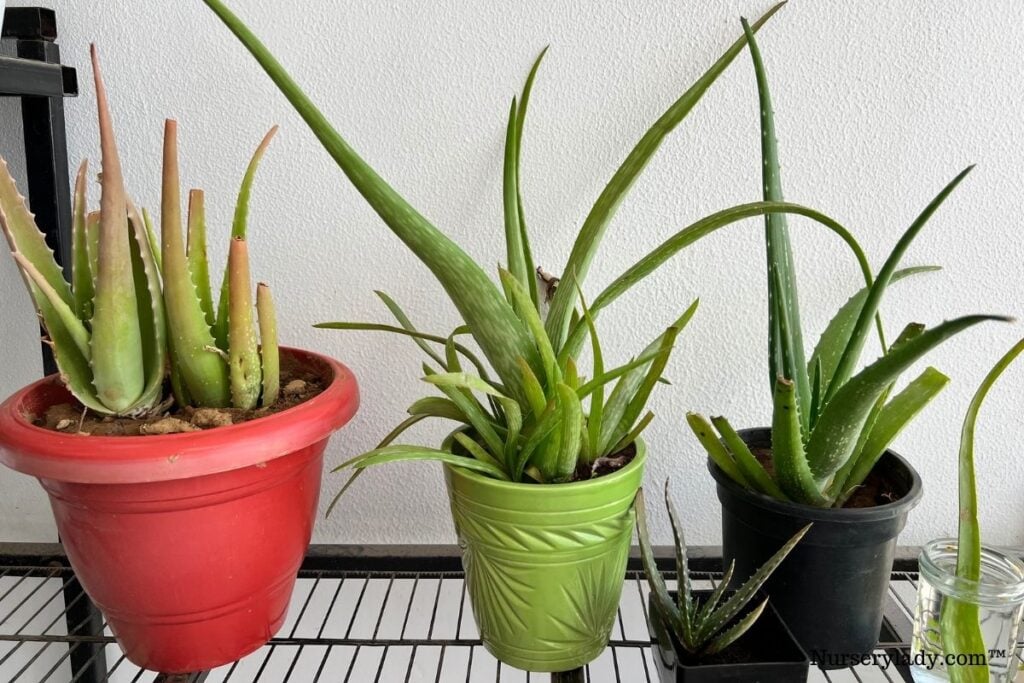
As I mentioned multiple times, Aloes are sensitive to excessive moisture levels, especially around the roots.
The container might be the culprit if your Aloe Vera plant is still mushy despite following the right watering and soil.
While using a container for the Aloe Vera plant, you must check the presence of drainage holes at the bottom.
If there are no drainage holes, the excess water will stay stagnant in the soil.
The roots will have lots of moisture around them and thus, make the plant soft and mushy.
Over time, the roots will begin to rot.
It is not only drainage responsible for mushy leaves.
A container larger or deeper than the plant and the roots will also have the same thing.
Aloes don’t need a deep container because their roots don’t grow deep but horizontally.
That is why a wider pot is much of their thing.
A large container will need lots of soil to fill up.
As a result, it will take a lot of time to dry out, thus making the roots damp for prolonged periods.
This slow-drying process will further lead to mushy plants.
What is the ideal container for Aloe Vera?
First, ensure the drainage of the planter.
It must have one drainage hole in the shape of the fingertip. Or, it should have multiple small holes.
If your container doesn’t have drainage holes, make one by drilling or repot your plant in a new one.
Make sure that you don’t do this after already repotting once.
Do this when it is time for repotting the Aloes.
Select a size that suits the size of the plant.
Take a container 3-6 inches wide in diameter.
The depth should be only 2-4 inches.
In general, the container should be 1/3rd larger than the plant size.
When repotting the Aloes, choose a 1-2 inches larger container than the old one.
To aid in drainage more, use terra cotta containers as they can wick away moisture quickly and keep your plant dry.
Most gardeners use saucers under the container.
It collects the water that flows out of the drainage holes of the planter.
You must empty the saucer from time to time without fail to prevent the soil from getting damp again.
When the plant gets too root-bound, the roots grow out of the drainage holes and block the drainage.
As a result, the water fails to drain out.
You must repot your Aloe Vera in time when you spot the signs of root-bound.
Many gardeners use decorative cache containers to hide their ugly pots.
Decorative pots don’t have drainage holes.
If you don’t take the main pot out, the excess water won’t escape and start pooling around the roots.
You must take the main pot out of the decorative pot during watering.
Once the water stops dripping from the drainage hole, you can put it back.
Also, check and empty the decorative container regularly if there is any water left.
Also read: How To Repot An Aloe Vera Plant? (Step-by-Step Guide)
High humidity levels
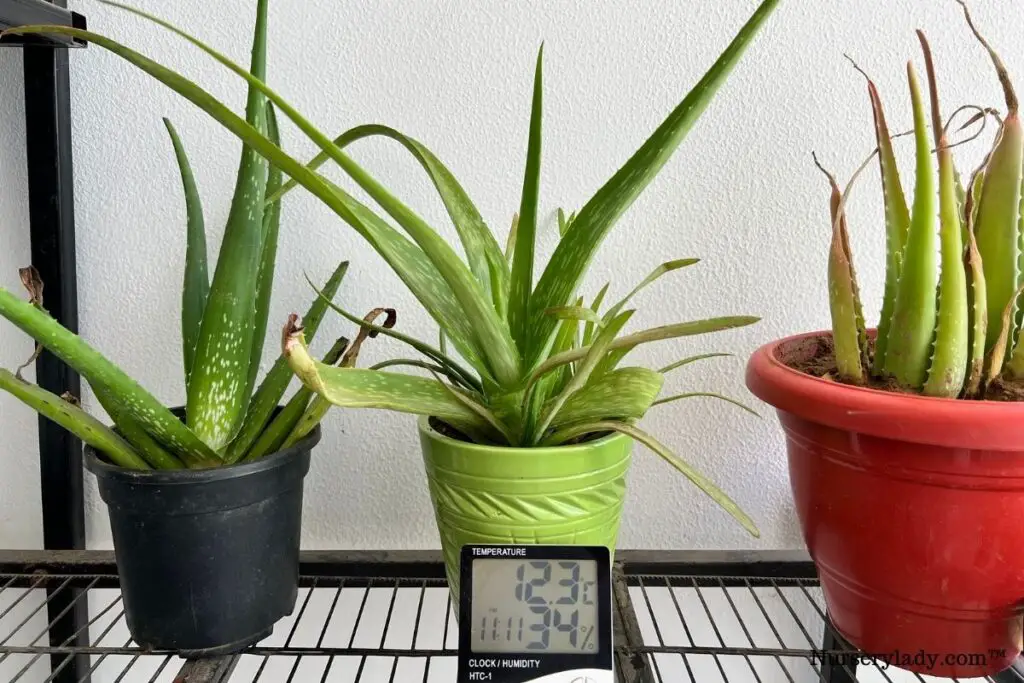
Thriving in dry areas, Aloes won’t enjoy high humidity levels around them.
Aloe Vera plant will enjoy low humidity ranging from 30% to 40%.
High humidity increases the dampness level around the Aloes.
The Aloe Veras can absorb moisture from the surrounding environment.
This will increase the plant’s moisture level and make the plant mushy.
It can also lead to fungus development and mold if the problem remains for extended periods.
How to maintain the right humidity?
If your plant becomes mushy despite maintaining the correct watering, drainage, and planter, check the humidity level around your plant.
High humidity is generally a problem for indoor plants due to insufficient sunlight and airflow.
- When your plant suffers from high humidity, shift them to a spot that receives 4 to 5 hours of sunlight daily.
- Maintain enough space around the plant for good air circulation.
- Check the moisture level of the soil. Scale back watering for some days until the soil dries out.
- Always plant the outdoor Aloe Veras in a sunny spot with proper air circulation. It will prevent high humidity and save your plant from getting mushy.
- You can also use de-humidifiers if your Aloe Vera plant is indoors.
Also read: Do Aloe Vera Like Humidity? (Ideal Humidity+How To Maintain)
Lack of sunlight

Aloe Veras are desert plants that can endure direct sunlight.
That is why they sometimes struggle indoors due to insufficient light.
It is essential to provide the plant with enough sunlight.
If Aloe Vera fails to get the sunlight they used to get in their natural habitat, the leaves will lean and bend halfway.
They will fold and shrivel and ultimately become soft.
They will also be mushy and squishy because lack of light leads to slow soil drying.
If you fail to notice any watering, drainage, or humidity signs, check for the light.
You might have kept them in the dark spot.
How to increase the light for Aloe Veras?
- The best lighting condition for Aloes would be direct sunlight for 4-6 hours in the morning and some shade from the harsh sunlight of the mid-day and afternoon.
- Simply shift the plant to a sunny spot. But don’t forget to acclimatize. First, keep the plant in a partially shady area for some days. Then, slowly expose them to the direct sun for 2-3 hours for a few more days. Slowly increase the timing.
- Follow the same process while shifting the indoor Aloe Vera plants outdoors.
- You can keep your Aloe Veras near a south or west-facing window. However, these directions sometimes give intense sunlight, especially during the summers.
- Put on transparent curtains. But, this direction is good in winters as the sun intensity and hour reduces, so does the risk of sunburn.
- You can put the plant near north or east-facing windows during the summers as they won’t receive any harsh sunlight.
- You can also use artificial lights for indoor Aloe Veras. Maintain a distance of 2 meters.
Also read: What Kind Of Light For Aloe Vera Plants? (Full sun, Shade, Or Partial Light?)
Sunburn
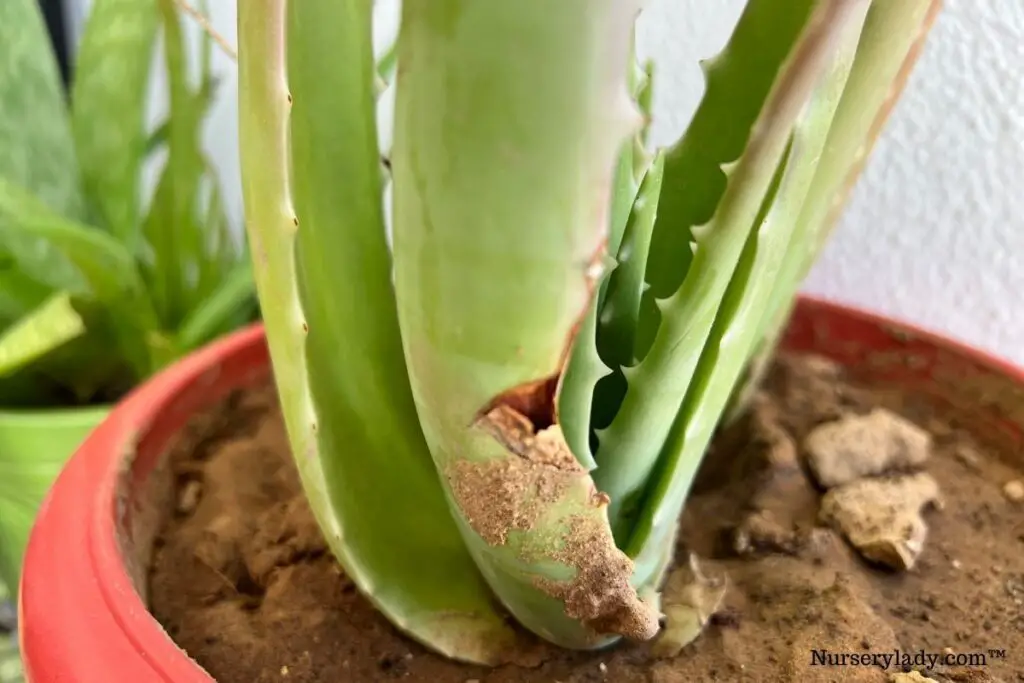
It might be surprising to hear, but it’s real.
Aloes will become soft and mushy even during sunburns in summers.
Aloe Veras can store water in the leaves, and this water will get heated up and make the leaves mushy.
This heated water also increases the chances of burning in the plants sitting under direct sunlight or close to window sills.
It will also develop big soft marks on the generally brown leaves.
The effects are first seen in the leaves close to the light.
How to reduce the exposure?
- If you find the leaves mushy and brown burning patches, you should immediately shift the plant to a partially shady place.
- If your aloe vera is planted in the ground, you must quickly fix on shading cloths to filter the sunlight.
- But remember, the plant shouldn’t receive complete shade as that will make the plant mushy. If the light creates problems on both edges, it is all about balance.
- The plant should get sufficient direct sunlight for some hours but not too intense or harsh for prolonged periods.
- The best is the direct sunlight in the morning and partial shade during the afternoon or mid-day.
Cold injury
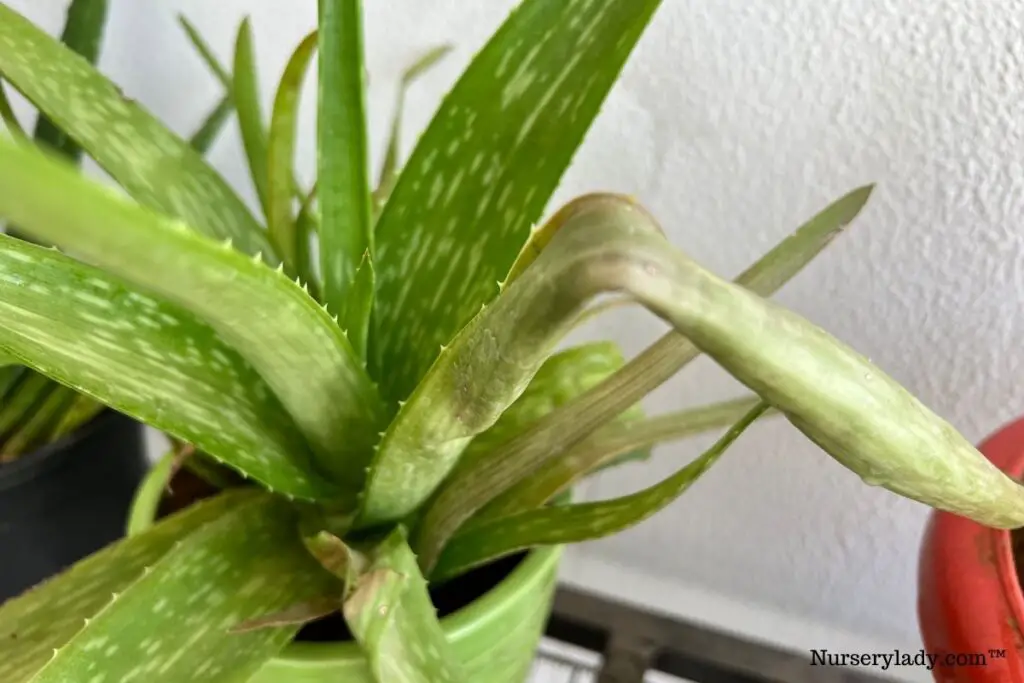
Aloes are native to dry and warm environments.
Cold is their weakness, and they cannot endure it.
If your region receives frost, you should never plant them.
Aloes should be shifted indoors in such weather.
If you keep the Aloes outside in temperatures below 50-55°F, the water inside the leaves will expand, freeze and burst.
Due to this, the cells and tissues will get damaged, and the leaves will become mushy and have wet black patches.
How to maintain the right temperature?
- The temperature should always range between 55 and 75°F. It should not go below 50°F.
- If your plant is outside in containers, bring them inside.
- If it is in the ground, cover them with frost cloths and also mulch the soil bed with stones or pebbles to trap the warmth and prevent the cold from reaching and shocking the roots.
- Let them have enough sunlight during the day and put on frost cloths when the sun begins to set. The sunlight will keep them warm.
- Don’t water them too frequently like the other times of the year. You should water once a month only to maintain hydration. You can even stop watering for some days if your plant has received a slight cold injury.
- Though you can keep the Aloes outside and take proper care of them, it is always better to bring them inside, especially if your living area never fails to get frost.
Also read: Can Aloe Vera Plants Survive Cold Weather? (+Deal With Cold Damage)
How to fix and prevent a mushy Aloe Vera?
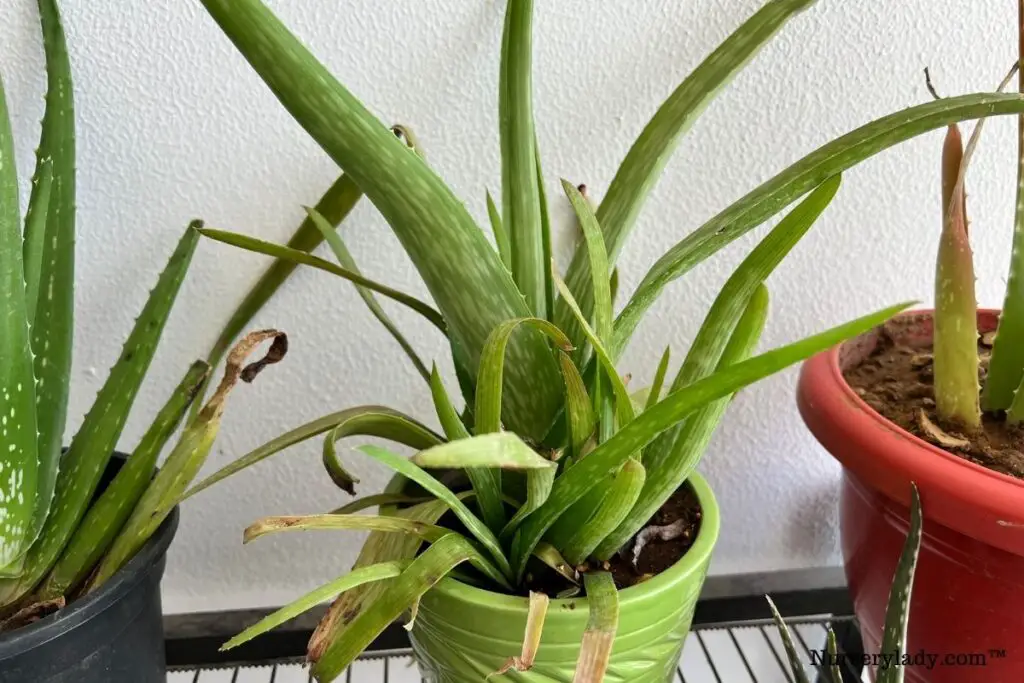
Allow the plant to dry out for a few days.
Once you see signs of recovery, water them in small amounts.
Don’t worry about less quantity because they are still recovering.
Start with normal care when they have fully recovered.
Water when 3/4th of the soil is dry.
| Factor | Care Tips |
|---|---|
| Planter | Use the right planter. Don’t use a very big or deep container or one with no drainage holes. Ensure the drainage first and use terracotta pots to help the draining process. |
| Soil | To improve soil drainage, add coarse sand, perlite, or gravel to the soil. You can also replace it with well-drained soil. Use commercial cactus and potting mix. Or, you can follow the soil mix I shared. |
| Light | Let them have at least 4-6 hours of direct sunlight per day in the morning. Also, maintain shade during the mid-day and afternoon, especially in the summers. Since the sun intensity and hours are less in winters, letting them have direct in the mid-day or afternoon won’t harm the Aloes. |
| Temperature | Protect them from cold temperatures and shift them to a warm place. Bring Aloes indoors when the temperature starts cooling in the fall. |
Should I trim the mushy leaves?
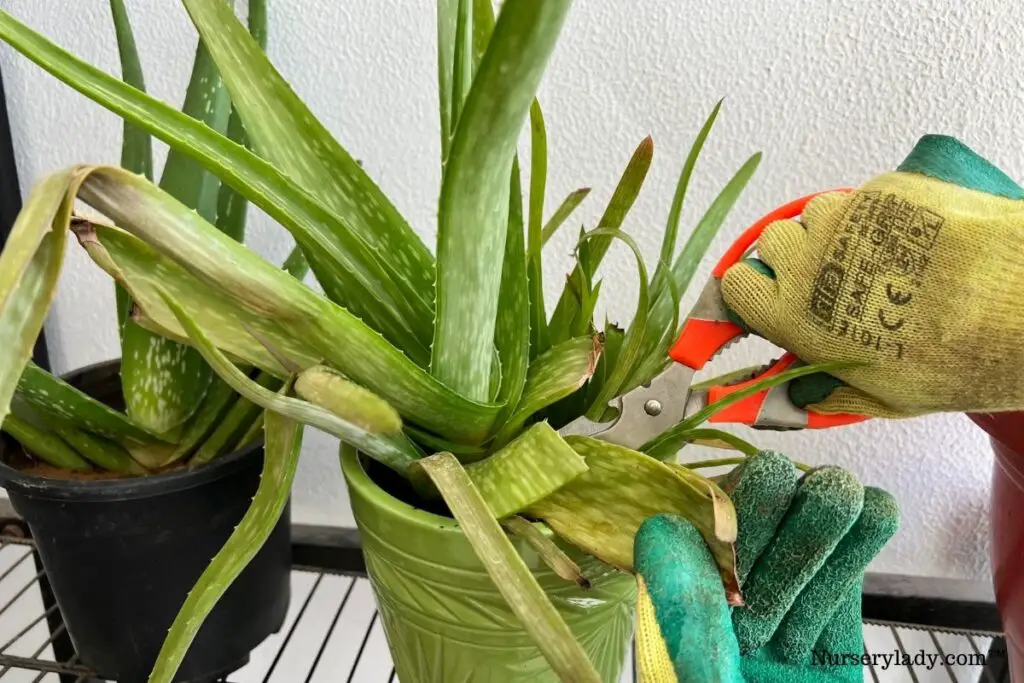
Pruning off the mushy leaves will allow your plant to grow new healthy leaves.
If you don’t remove them, the plant will constantly waste energy to revive them, and the plant cannot grow new leaves.
That is why trimming them is the best way to let your plant live and grow energetically.
However, you can keep the partially affected leaves.
If they are slightly affected, they will be back to health once the plant has recovered.
Final words
If your Aloe Vera has mushy leaves, go through the above reasons and check which condition matches the present state of your Aloe Vera. Treat the plant as per the requirement.
If you spot the problem at the initial stage and take immediate steps, your Aloe Vera will make a grand comeback. But if the problem has spread so much that revival is impossible, you have to bring the plant back through propagation.
Mushy Aloe Vera is not the end of your plant unless the problem has spread to the whole plant. You can always bring your precious plant back with the right steps at the right time.
Reference: NCBI, New York Botanical Garden, University of New Hampshire, University of Florida, Wikipedia.
